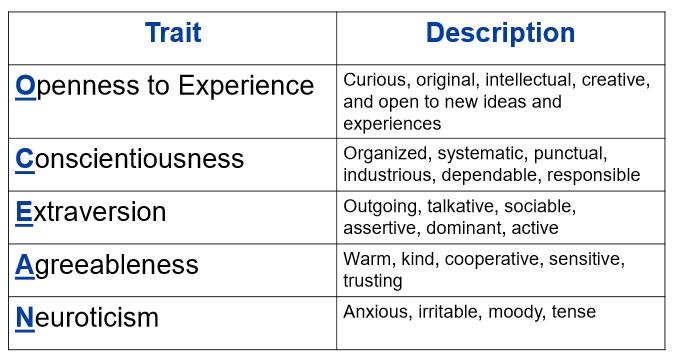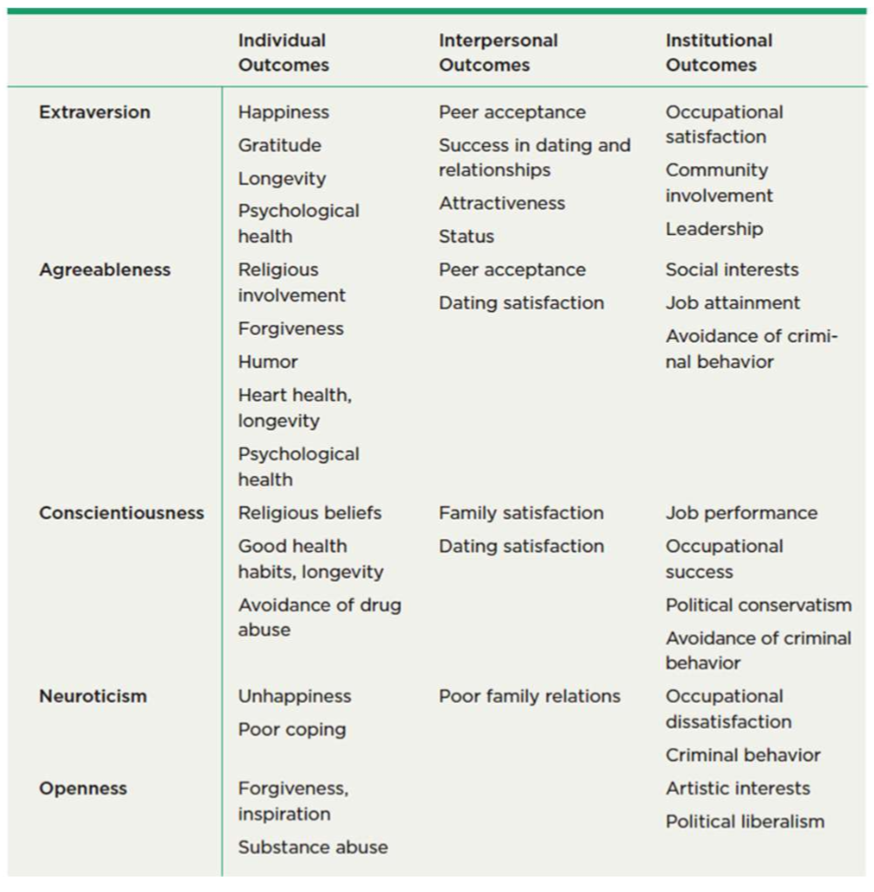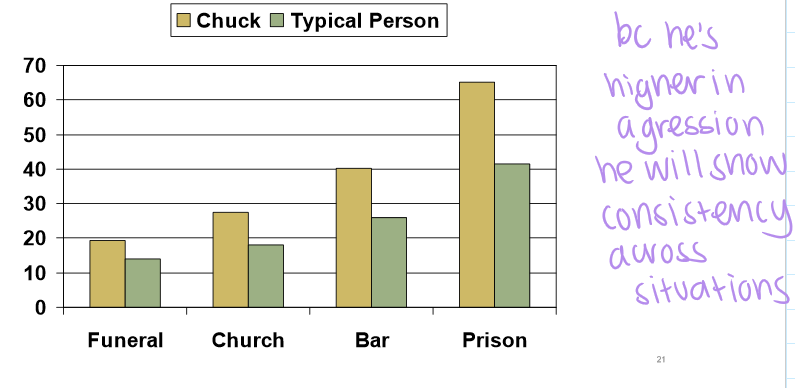Lecture 4 (Trait Approach- Big 5 and PS debate)
1/15
There's no tags or description
Looks like no tags are added yet.
Name | Mastery | Learn | Test | Matching | Spaced |
|---|
No study sessions yet.
16 Terms
Theoretical approaches in personality psych
• Trait approach
• Biological approach
• Psychodynamic approach
• Phenomenological approach
• Learning/cognitive approach
Assumptions of Trait approach
1. Building blocks of personality
2. Comparative
3. Influence behaviors
4. Predict important life outcomes
5. Consistent across situations
6. Stable over time
7. Partially biologically based
Assumptions of Trait approach: Building blocks of personality
• Individuals differ in their typical patterns of thoughts, feelings, and behaviors, and these patterns are called traits
Examples:
• Talkative
• Organized
• Punctual
• Kind
• Friendly
• Creative
building blocks: approaches to creating taxonomies
• Theoretical approaches to reducing the many to a few (what do we theoretically see in the world)
What do we think, in theory, are the basic building blocks of personality
• Carl Jung → proposed archetypes (universal personality patterns).
Myers-Briggs (MBTI) → based on Jung’s theory, divides people into types (e.g., introvert/extrovert, thinker/feeler).
• atheoretical Factor analytic (statistical, purely quantitative) approaches to reducing the many to a few
It’s data-driven, not based on prior theory — researchers let the data reveal which traits go together.
• Raymond Cattell → found 16 personality factors (16PF).
Tellegen → used factor analysis to find major personality dimensions.
• Lexical approach
So by studying personality adjectives (e.g., kind, honest, bold), we can discover the basic dimensions of personality
• We use words to describe ourselves and others
• If some aspect of personality is important, then people everywhere will have words for it (cross-cultural universality) of what personality entails
• if we have words for it, maybe it will tell us abt the human structure of personality
• personality is rooted in the words we use to describe ourselves and others
big 5 dimensions
• Based on lexical studies
• Started with 17,953 trait terms!
• Statistical procedure (factor analysis) identified five broad dimensions
• “Big Five” dimensions replicate
• in self and informant reports
• in (some) other cultures: limit is they used English dictionary
**trying to apply big 5 of english to other cultures is not ideal, found big 7 big 2 in other cultures
• in other species
Big 5 (7 of them)
• Can bring order to many research findings by providing a common language in which to study personality
• More complex than they seem at first
• Lower-order factors or facets
• The Big Five is a structure of traits not people (not types just a way of organizing)
• There is more to personality than traits
• Conceptually, traits are orthogonal, or unrelated to one another (they are uncorrelated to one another)
• The Big Five are not theoretically-derived (more statistical)
• Unclear cross-cultural generalizability

Assumptions of trait approach: comparative
traits characterize differences among ppl
Assumptions of trait approach: influence behavior
traits help us understand how a person might behave
Assumptions of trait approach: predict life outcomes

Assumptions of trait approach: consistent across situations
• People who are friendly at school also tend to be friendly at home, at work, in social settings, etc.
• Does NOT mean you are the same in every situation (it wont be same bar height exactly)

Assumptions of trait approach: partially biologically based
Situationism
• Emphasis on the power of the situation to shape people’s behavior
• Zimbardo’s prison study
• Asch’s conformity study
• Milgram’s obedience study
• Strict situationists, like Mischel, claim that:
• personality is not real
• personality only exists in the minds of perceivers (no real stability)
Abu Ghraib prison
• The situation made them do it
• “You could put almost anyone in that situation and you’re going to get evil behavior. They’re probably loving husbands and fathers at home.” – Dr. Phil Zimbardo
• Their personality traits predisposed them to do it
• Aggression and other antisocial traits are stable over time and across situations
Chuck Granger and Lynndie England
history of prison abuse and DV
Conclusion: Graner has a predisposition toward violence (i.e., aggressive traits) The Abu Ghraib prison didn’t make him violent; it simply allowed him to express his violent nature
history of being timid/fearful
Conclusion: “An overly compliant personality in the face of perceived authority” –Psychologist at England’s trial
are there exceptions??
interactionism
• Situations shape how personality traits are developed and expressed
• People’s personality traits shape what the environment becomes
Conclusion person situation debate
• The person-situation debate reflects a divergence in emphasis, not the all-or-nothing stance that is assumed to characterize (and divide) social and personality psychologists